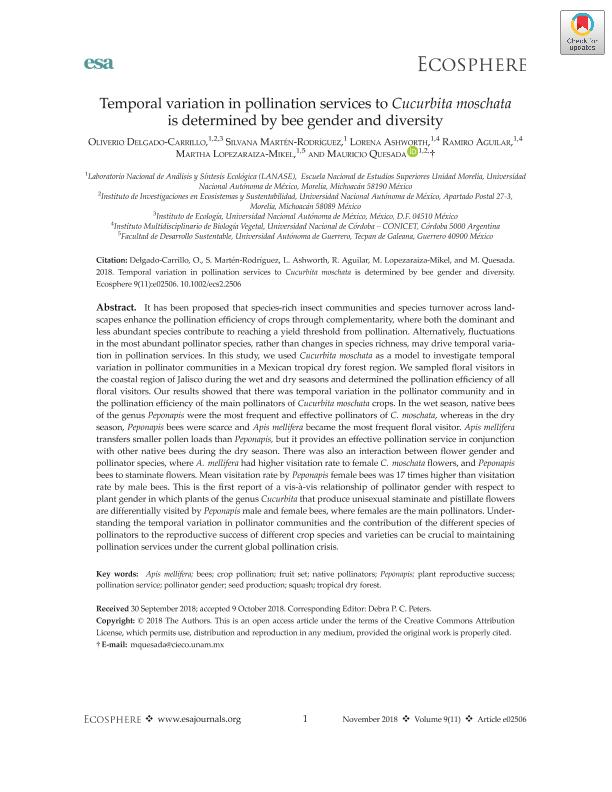Mostrar el registro sencillo del ítem
dc.contributor.author
Delgado-Carrillo, Oliverio
dc.contributor.author
Martén-Rodríguez, Silvana
dc.contributor.author
Ashworth, Lorena

dc.contributor.author
Aguilar, Ramiro

dc.contributor.author
Lopezaraiza-Mikel, Martha
dc.contributor.author
Quesada, Mauricio
dc.date.available
2019-11-04T16:49:32Z
dc.date.issued
2018-11
dc.identifier.citation
Delgado-Carrillo, Oliverio; Martén-Rodríguez, Silvana; Ashworth, Lorena; Aguilar, Ramiro; Lopezaraiza-Mikel, Martha; et al.; Temporal variation in pollination services to Cucurbita moschata is determined by bee gender and diversity; Wiley-Blackwell; Ecosphere; 9; 11; 11-2018
dc.identifier.issn
2150-8925
dc.identifier.uri
http://hdl.handle.net/11336/87900
dc.description.abstract
It has been proposed that species-rich insect communities and species turnover across landscapes enhance the pollination efficiency of crops through complementarity, where both the dominant and less abundant species contribute to reaching a yield threshold from pollination. Alternatively, fluctuations in the most abundant pollinator species, rather than changes in species richness, may drive temporal variation in pollination services. In this study, we used Cucurbita moschata as a model to investigate temporal variation in pollinator communities in a Mexican tropical dry forest region. We sampled floral visitors in the coastal region of Jalisco during the wet and dry seasons and determined the pollination efficiency of all floral visitors. Our results showed that there was temporal variation in the pollinator community and in the pollination efficiency of the main pollinators of Cucurbita moschata crops. In the wet season, native bees of the genus Peponapis were the most frequent and effective pollinators of C. moschata, whereas in the dry season, Peponapis bees were scarce and Apis mellifera became the most frequent floral visitor. Apis mellifera transfers smaller pollen loads than Peponapis, but it provides an effective pollination service in conjunction with other native bees during the dry season. There was also an interaction between flower gender and pollinator species, where A. mellifera had higher visitation rate to female C. moschata flowers, and Peponapis bees to staminate flowers. Mean visitation rate by Peponapis female bees was 17 times higher than visitation rate by male bees. This is the first report of a vis-à-vis relationship of pollinator gender with respect to plant gender in which plants of the genus Cucurbita that produce unisexual staminate and pistillate flowers are differentially visited by Peponapis male and female bees, where females are the main pollinators. Understanding the temporal variation in pollinator communities and the contribution of the different species of pollinators to the reproductive success of different crop species and varieties can be crucial to maintaining pollination services under the current global pollination crisis.
dc.format
application/pdf
dc.language.iso
eng
dc.publisher
Wiley-Blackwell
dc.rights
info:eu-repo/semantics/openAccess
dc.rights.uri
https://creativecommons.org/licenses/by-nc-sa/2.5/ar/
dc.subject
APIS MELLIFERA
dc.subject
BEES
dc.subject
CROP POLLINATION
dc.subject
FRUIT SET
dc.subject
NATIVE POLLINATORS
dc.subject
PEPONAPIS
dc.subject
PLANT REPRODUCTIVE SUCCESS
dc.subject
POLLINATION SERVICE
dc.subject
POLLINATOR GENDER
dc.subject
SEED PRODUCTION
dc.subject
SQUASH
dc.subject
TROPICAL DRY FOREST
dc.subject.classification
Ecología

dc.subject.classification
Ciencias Biológicas

dc.subject.classification
CIENCIAS NATURALES Y EXACTAS

dc.title
Temporal variation in pollination services to Cucurbita moschata is determined by bee gender and diversity
dc.type
info:eu-repo/semantics/article
dc.type
info:ar-repo/semantics/artículo
dc.type
info:eu-repo/semantics/publishedVersion
dc.date.updated
2019-10-24T18:18:22Z
dc.identifier.eissn
2150-8925
dc.journal.volume
9
dc.journal.number
11
dc.journal.pais
Reino Unido

dc.description.fil
Fil: Delgado-Carrillo, Oliverio. Laboratorio Nacional de Análisis y Síntesis Ecológica; México. Universidad Nacional Autónoma de México; México
dc.description.fil
Fil: Martén-Rodríguez, Silvana. Laboratorio Nacional de Análisis y Síntesis Ecológica; México
dc.description.fil
Fil: Ashworth, Lorena. Laboratorio Nacional de Análisis y Síntesis Ecológica; México. Consejo Nacional de Investigaciones Científicas y Técnicas. Centro Científico Tecnológico Conicet - Córdoba. Instituto Multidisciplinario de Biología Vegetal. Universidad Nacional de Córdoba. Facultad de Ciencias Exactas Físicas y Naturales. Instituto Multidisciplinario de Biología Vegetal; Argentina
dc.description.fil
Fil: Aguilar, Ramiro. Laboratorio Nacional de Análisis y Síntesis Ecológica; México. Consejo Nacional de Investigaciones Científicas y Técnicas. Centro Científico Tecnológico Conicet - Córdoba. Instituto Multidisciplinario de Biología Vegetal. Universidad Nacional de Córdoba. Facultad de Ciencias Exactas Físicas y Naturales. Instituto Multidisciplinario de Biología Vegetal; Argentina
dc.description.fil
Fil: Lopezaraiza-Mikel, Martha. Universidad Autonoma de Guerrero; México
dc.description.fil
Fil: Quesada, Mauricio. Laboratorio Nacional de Análisis y Síntesis Ecológica; México
dc.journal.title
Ecosphere
dc.relation.alternativeid
info:eu-repo/semantics/altIdentifier/url/https://esajournals.onlinelibrary.wiley.com/doi/full/10.1002/ecs2.2506
dc.relation.alternativeid
info:eu-repo/semantics/altIdentifier/doi/https://doi.org/10.1002/ecs2.2506
Archivos asociados
